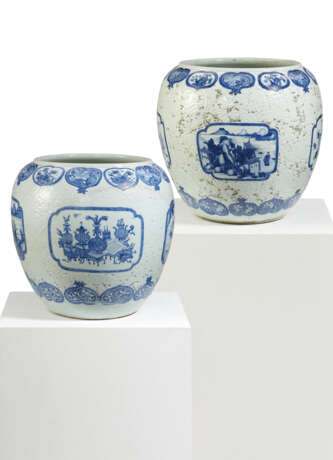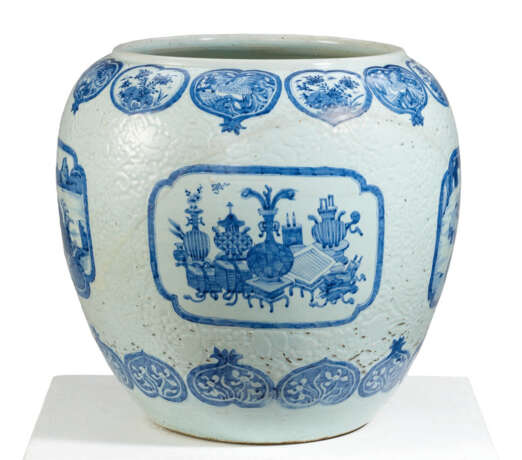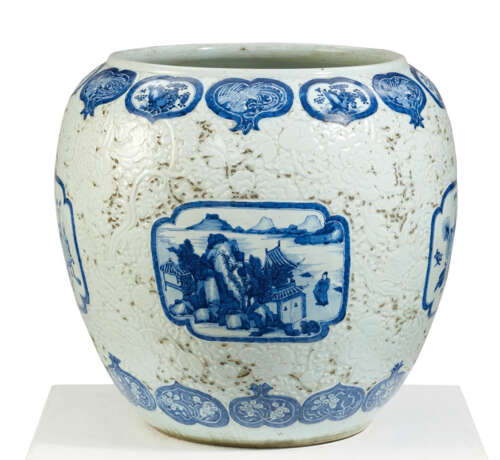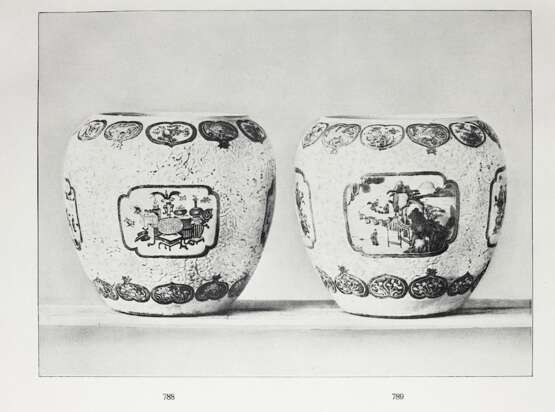ID 1207104
Lot 632 | PAIR OF IMPORTANT PORCELAIN JARDINIÉRES WITH CUT PEONY DECORATION
Valeur estimée
€ 30 000 – 40 000
Origin: China.
Dynasty: Kangxi period (1622-1722).
Technique: Porcelain with white glaze and blue decor.
Description: On a flat, unglazed base, steep, spherically moulded wall with thickened lip rim. Each
circumferentially decorated with a flat incised Qilong dragon between a dense peony
blossom ground, with four rectangular reserves filled at the corners in deep cobalt blue
with mountainous river landscapes with figures and the 1000 treasures, the shoulder and
foot additionally surrounded by a wreath of heart- and pomegranate-shaped reserves filled
with lotus branches, flowers growing out of rocks and a phoenix, also in cobalt blue.
Measurement: Height each 50cm, ø ca. 53cm.
One basin restored. Glaze rubbed in places on both.
Provenance:
- Collection of Augustus the Strong, Johanneum Dresden.
- Auction Rudolf Lepke's Kunst-Auctions-Haus Berlin, 12 October 1920, Dresden, catalogue nos. 788-789, ill. plate 39.
- Inventory Kunsthandlung A.S. Drey, Munich, 1920.
- Auction Paul Graupe Berlin, 17 and 18 June 1936, cat. No.356, illus. plate 68.
- Porcelain collection of Ernst Georg Schneider (1900-1977).
- On permanent loan to the Ernst Georg Schneider Foundation in Schloss Jägerhof, Düsseldorf and purchased by the City of Düsseldorf in 1987.
- Restituted to the heirs of the former partners of the Kunsthaus A.S. Drey November 2023.
Literature:
- Auction catalogue Rudolph Lepke's Kunst-Auctions-Haus, Berlin: Porcelain, paintings, ivory sculptures, weapons from the Saxon State Collections - Johanneum, Grünes Gewölbe, Gemäldegalerie in Dresden. Auction in Dresden, Tuesday, 12 October 1920, p.46, cat. nos. 788, 789, plate 39.
- Auction catalogue Paul Graupe, Berlin: Aus dem Besitz der Firma A.S. Drey München (Räumungsverkauf), 17 and 18 June 1936, p.60, cat. no. 356, plate 68.
- Link to the catalogue entry for a comparable cache pot from the SKD collection in the Dresden Zwinger: https://royalporcelaincollection.skd.museum/unique/object/157845.
The two large cachepots presented here are characterised not only by their impressive size and elaborate glazing technique, but above all by the history of their provenance. They were originally part of the porcelain collection of Augustus the Strong (1670-1733) in Dresden. The Saxon Elector had fallen victim to the so-called "maladie de porcelaine" very early on. Not only did he found the first European porcelain manufactory in 1710, but he also passionately collected porcelain objects of Chinese and Japanese origin, which served as an incentive and model for founding the manufactory. He is probably best known for the so-called dragon vases from the Kangxi period, which he received from Frederick William I of Prussia in 1717 along with other pieces in exchange for 600 horsemen from his army. The Chinese porcelains in the collection also found their way to his court via Dutch dealers, for example, and were exhibited in the Japanese Palace, which was specially remodelled as a "porcelain palace", together with the products of his own porcelain manufactory.
The two large cachepots - as well as the other pieces still in the Dresden porcelain collection today - were probably planted with small trees, more precisely orange trees, during the reign of Augustus the Strong, as the inventory mentions. Today's presentation of the collection shows them, now of course unplanted, impressively staged in the East Asia Gallery of the Zwinger.
In October 1920, the two cachepots presented here were then offered for sale at an auction in favour of the Sächsischer Kunstverein in Dresden, together with other exceptional works from the former royal and now state collection. They were listed as "Two large flower pots" under lot numbers 788 and 789 (see also the historical photograph from the auction catalogue at the time). It was the second auction of this kind to generate funds for new acquisitions. "For the most part, they belong to the old holdings that King Augustus the Strong, who loved splendour and art, and his no less art-loving successor King Augustus III of Poland brought together in the 18th century and which became the basis of Dresden's world-famous collections" (Lepke 1920, foreword). Duplicate pieces from the collection were selected and, in addition to the cache-pots on offer here, not only a few other cache-pots but also vase sets, monumental lidded vases and figurines from the field of Chinese porcelain were offered.
From 1920 onwards, the two cache pots presented here were part of the inventory of the art dealership A.S. Drey, founded by Aron Schmay Drey in Munich in 1866. The company was still family-owned at the beginning of the 1930s and under the Nazi regime its descendants were persecuted and the art dealership was forced to close. As a further reprisal, high back taxes and fines were demanded as part of this persecution. To settle these claims, the owners were forced to sell the art dealership's inventory in a clearance sale at auction. On 17 and 18 June 1936, in addition to numerous other art objects, the two cache pots presented here were also offered at the auction of the Graupe auction house in Berlin (lot 356, plate 68).
Graupe's buyer at the time is unknown, but the two pieces later found their way into the collection of the entrepreneur and patron of the arts Ernst Schneider (1900-1977). During his lifetime, he was already very active on various committees of theatres and art collections and was a founding member of several societies, such as the Gesellschaft der Keramik-Freunde Düsseldorf. In addition to silver and furniture from the 18th century, his collection includes an exceptionally large number of early porcelains of the highest quality from the Meissen manufactory. The majority of the Meissen porcelain collection of the Ernst Schneider Foundation has been in the possession of the Bavarian National Museum since 1968 and has been exhibited in Lustheim Palace since 1971. After the collection of the Dresden Zwinger, it is considered one of the largest and most important collections of 18th century Meissen porcelain. A first part of his collection was exhibited on permanent loan at Schloss Jägerhof in Düsseldorf from 1955, including the two large cache-pots on display here. These were purchased by the City of Düsseldorf in 1987 and restituted to the heirs of the former partners of the Kunsthaus A.S. Drey at the end of 2023 in the course of research by the Provenance Research Centre.
We are now delighted to be able to present these two extraordinary objects and their chequered history to you at VAN HAM..
| Catégorie maison de vente aux enchères: | Art asiatique : Porcelaine chinoise, céramique |
|---|
| Catégorie maison de vente aux enchères: | Art asiatique : Porcelaine chinoise, céramique |
|---|
| Adresse de l'enchère |
VAN HAM Kunstauktionen GmbH Hitzelerstr. 2 50968 Köln Allemagne | ||||||||||||||
|---|---|---|---|---|---|---|---|---|---|---|---|---|---|---|---|
| Aperçu | |||||||||||||||
| Téléphone | +49 221 92586215 | ||||||||||||||
| Fax | +49 221 92 58 62 4 | ||||||||||||||
| Commission | 32% | ||||||||||||||
| Conditions d'utilisation | Conditions d'utilisation | ||||||||||||||
| Heures d'ouverture | Heures d'ouverture
|






